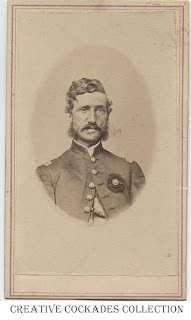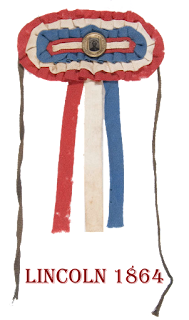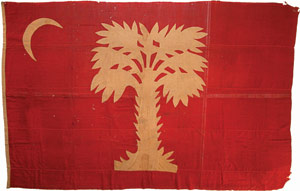In my ten years of recreating and selling authentic cockades, I have helped many people choose just the right political cockade for their impression. Probably the most entertaining encounter I had was with a lady who insisted on choosing an American Civil War cockade to “match her dress.” I tried to point out that there was a big difference between wearing a pro-secession cockade and a pro-union cockade, but she airily dismissed my concerns. It had to match the dress!
I’m assuming most of y'all care a bit more deeply about making sure your cockade is correct for your historic persona. The heyday for cockades in America was 1850-1900, so there are dozens of options for you to choose from. Clubs, fraternities, funerals, processions, festivals, fundraisers, political events, campaigns, you name it! People wore cockades for all of these to identify with a cause or signify some kind of rank or service.
So.... How do you choose what to wear?
For the purposes of this article, I’m simply going to cover political cockades. (Otherwise, this might turn into a book!) But do be aware that there are many other types of cockades that can be designed and worn for your historic events if you wish. Meanwhile, let’s take a look at how to choose the appropriate political cockade for your Civil War impression!
Which side are you on?
As noted above, there were cockades (typically rosettes made out of ribbon) for both North and South in 1860s America. As we all know, however, history is not quite as cut and dried as that. In every southern state that seceded, there were those who were pro-union. And in every state in the Union, there were those who were either pro-secession or at least sympathized with the South. You’ll need to decide what your politics are before you can make any further decisions regarding your political badges.
Pro-union cockades were almost always red, white and blue, often called “tricolor.” The center emblem, if there was one, was generally left up to the wearer’s fancy unless it was a mandatory military cockade. Stars, military buttons, and small pictures of famous Americans (such as George Washington) were fashionable as centers.
Pro-secession cockades fall into two general categories, Southern cockades and Northern Copperhead badges.
Southern cockades were generally all blue, all red, or red and white. Once again, center emblems include stars, military buttons and pictures, but additionally southern products such as palmetto fronds, pine burs, corn or cotton were used. These homegrown products emphasized the agrarian nature of the Confederacy, as opposed to the more industrialized North.
These pro-South badges could be worn in the North as well as the South, but the pro-South movement in the North also had another badge – the Copperhead. Copperheads wore a copper “Lady Liberty” cent on their watch fobs, or had the head of Lady Liberty cut out and made into a stick pin.
One other small niche of cockade designs was worn by both sides – a black, or black and white cockade. This harkens back to America’s beginnings in the 1770s, when the Continental Army’s official cockade was black or black and white. The idea, used by both Northerners and Southerners, was to show that their cause was the one truly representing the ideals of America’s founding.
What year are you representing?
In 1860-61, patriotic fervor (both pro- and anti-secession) was at its height. The reality of a bloody war had not yet set in and many thought the coming conflict would be minimal. It was popular and fun to not only pick a side, but to publicly show your sentiments with a cockade. We see account after account like this one from a southern newspaper:
“SECESSION MEETING IN GEORGIA. Columbus, Nov. 24. The demonstration made here to-day was the greatest ever seen in Western Georgia. All the merchants closed their stores and joined in the procession. Flags and banners were suspended on the streets, the military and Southern Guard paraded in procession, and cannon were fired as a salute to the Southern Confederacy. Messrs. Yancey and Rice spoke in the morning to a crowd of 5,000 people. John Cochrane, of Alabama, spoke at night, with Senator Iverson and Mr. Crawford. Nine-tenths of the people – men, women and children – wear the disunion cockade.”
Northern accounts speak of the holiday atmosphere in cockade-wearing as well. “The uniforms on drill were fantastic - some self-made paper hats, tri cockade, square and round, as fancy designed; others, for pantaloons, had their blankets folded over a string much like the Kilt of the Scot, bound to the waist by a knotted cord, or a wooden skewer for a pin. Truly, we may have been taken for some of our forbears, who had risen from their tombs and wandered over from Valley Forge to give us inspiration for the awful struggle yet to come, which no one of us, looked up in a serious light, all nearly with the view that it was to be a holiday only.” (The Andersonville Diary & Memoirs of Charles Hopkins, 1st New Jersey Infantry)
As the war progressed and the casualty list increased, patriotism was no longer a “fun” thing to be celebrated, but a deeply-felt principle to be supported with your life and military service (for men) or your material aid and comfort (for women). Cockades became more rare in 1862-65.
Sam Watkins in “Co. Aytch” reported early in the war, “Everywhere could be seen Southern cockades made by the ladies and our sweethearts.” By 1862 though, he said, “I saw then what I had long since forgotten – a ‘cockade.’ The Kentucky girls made cockades for us, and almost every soldier had one pinned on his hat.”
Fannie Beers in Louisiana also recalled the cockade-wearing to be short-lived. “Who does not remember the epidemic of blue cockades which broke out in New Orleans during the winter of 1860 and 1861, and raged violently throughout the whole city? The little blue cockade, with its pelican button in the centre and its two small streamers, was the distinguishing mark of the “Secessionist.”
Cockades certainly appeared throughout the war, but the height of their popularity was 1860-61. A popular gathering, such as a fundraiser or general’s visit, could prompt the crowd to bring out the cockades again in later years. But in general, the mass wearing of them in the streets faded after 1861.
The exception to this was the presidential election of 1864 and Lincoln’s death in 1865. Both occasions brought out in the North many specialized cockades with the proper person’s picture in the center or a printed pendant with the person’s name. Tricolor cockades were generally used for presidential candidates. Black cockades were usually used for mourning Lincoln’s death.
Copperheads also had their heyday in 1864, the year of the presidential election. They controlled the Democratic platform and ending the war was one of their major campaign goals. When Lincoln won reelection, the Copperhead movement basically died.
Are you civilian or military?
Both civilians and soldiers wore cockades. Civilians’ cockades tended to be designed according to the wearer’s fancy. If a soldier was wearing a cockade provided by a friend or sweetheart, it was also usually designed by the maker. But in many cases, especially early in the war before uniforms on both sides became centrally standardized, regiments often had their own cockades. This happened most frequently in the South, but Northern militia regiments occasionally used them before later being absorbed into the regular US army.
If you are part of a reenacting unit that is militia or early war, you should check your unit’s historical records to see if such a cockade was designed for you. Here is one example.“The scarlet cockade and steel button, of which we spoke yesterday, has, we learn, been unanimously adopted by the Edgefield Riflemen, and is now a pledge by them to resist Black Republican rule in or out of South Carolina. The motto is “Blood and Steel”—a reliable cure for present troubles.”
What state/region are you in?
Though the pro-Union cockade seems have been universally tricolor, pro-secession cockades varied wildly from state to state. For instance, this popular item in Northern newspapers described cockades from several Southern states:
“South Carolina.—The cockade is made of three layers of very dark cloth, stitched at the edges and fastened together by a gilt button, on which the following appears in relief: In the center is the "Palmetto," with two arrows (crossed,) and fastened together at the point of crossing with a bow know of ribbon. The following is the motto around the button: Animous opibusque parati—"Ready with our minds and means."
Virginia.—This consists of a double rosette of blue silk, with a pendant of lemon color, the whole fastened together by a gilt button on which appear in relief the arms of Virginia, with the name of the State and its motto encircling it. Its motto is "Sic Semper Tyrannis."
Maryland.—The cockade is formed of a double rosette of blue silk, with blue pendants, and fastened the same as that of Virginia, with the State button, and the single world "Maryland" beneath the arms.”
This is by no means an exhaustive list of the various types of Southern cockades. North Carolinians often used pine burs on their cockades. One Arkansian account speaks of cotton and corn being featured on Arkansas cockades. If you want your cockade to be truly representative of your region, I recommend you either contact me for more information or search online newspapers and diaries from your area for references to cockades. (Use the words cockade, badge, rosette and ribbon, as they can all refer to the same thing.)
What is your socio/economic status?
As you may have gathered from the quotes I’ve given so far, cockades were worn by men and women, adults and children. They were also worn by white and black, and poor as well as rich. Regardless of your status, you can wear a cockade. However, your position in life could have an impact on what the cockade looks like.
Cockades were sold both retail and wholesale, so if you had money, you could purchase one. The price in the ads I’ve found seems to have generally been around 25-30 cents. You could also buy the ribbon and make the cockade yourself (or have your wife or sweetheart do it for you). Cockades were made from cotton, silk and wool, all of which would have been readily available in a lady’s sewing workbox.
The accounts of poorer folks wearing cockades imply that they were likely wearing a simple strip or rosette of ribbon. In one account, it was noted that, “A number of charcoal dealers, from the interior of this district, were yesterday here on business, wearing—not the blue silk cockade—but plain strips of brown paper, bearing such mottoes as “Resistance,” “Remember Harper’s Ferry,” etc. We could not but admire the stern simplicity of this unpretending badge of devotion to South Carolina:—
The honest man, tho’ e’er sae poor,
Is king of men for a’ that.”
Some slaves apparently were able to either make or buy cockades themselves. I found several accounts mentioning them wearing these badges. “The negroes of A.S. Coleman, Esq., of this place, created quite a sensation in that town yesterday, by appearing on the streets with blue cockades on their hats. It learns from Mr. Coleman that they requested the privilege of wearing them, as they said, to show their contempt for the abolitionists, and their love for their native South.”
How to use your cockade in your impression
So, using your politics, your region, and your status, you have now created the perfect cockade for your impression! What will you do with it?
Cockades can be conversation-starters simply by wearing them. When explaining my badge to a spectator, I usually say that cockades are the “lapel pins” of the past. Then I try to draw an analogy of something they wear in modern life to support a cause – a t-shirt, hat or pin. Then I explain that wearing a cockade in the 1860s could be fun, but it could also be serious – cockades could literally start riots if you wear them in the wrong crowd! It’s pretty easy to bring up modern illustrations of how this could happen, to help them understand (wearing a MAGA hat to a Democrat rally, for example).
Then I use my cockade as a jumping-off point to discuss my “cause” further if the spectator is interested. Why am I pro-secession? Or perhaps, why am I wearing a badge to support Breckinridge instead of Lincoln? Do some research and have some fun with this.
You can create more intricate scenarios with cockades if you are interested and can get several other reenactors to help you. As I noted, cockades could start arguments, fights and riots. I’ve read a number of accounts of people trying to yank someone’s cockade off their hat or coat (ladies did this too!). A man could be kicked out of a bar for wearing an unpopular cockade. Officers have been documented to openly call out or sneer at a man wearing a badge from the opposite side. In one account, a lady was barred from receiving a teacher’s certificate because she was wearing a Copperhead badge. Politics was a blood sport in the 1860s. Try recreating these incidents to have some fun with your cockade!
As a final note, if you’re not sure where to start researching original descriptions and incidents concerning cockades, I have two digital books available in my shop that are compilations of quotes concerning Southern cockades and Northern cockades, respectively.
Have fun telling YOUR story with a cockade!






































